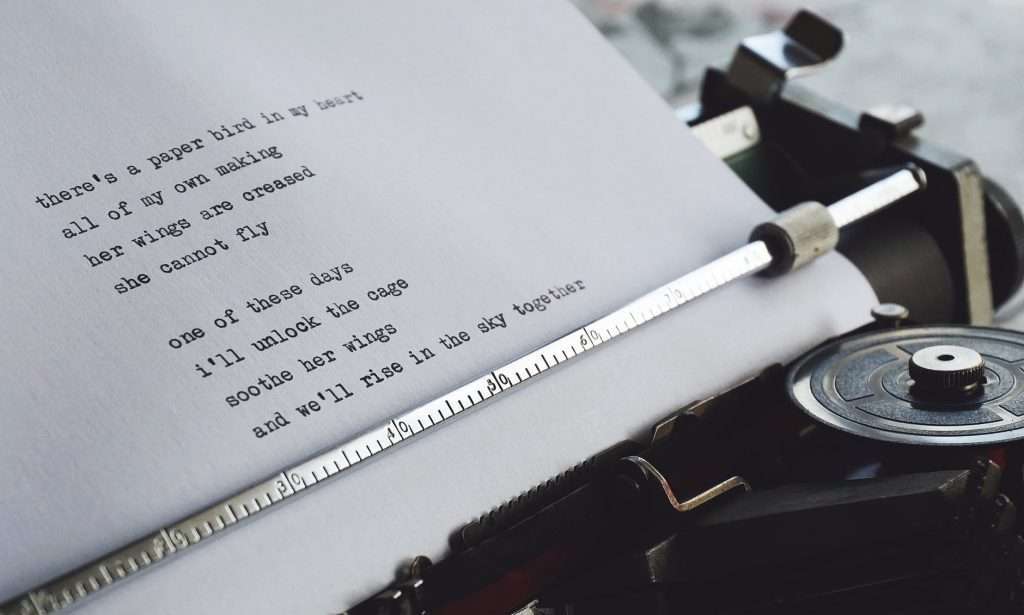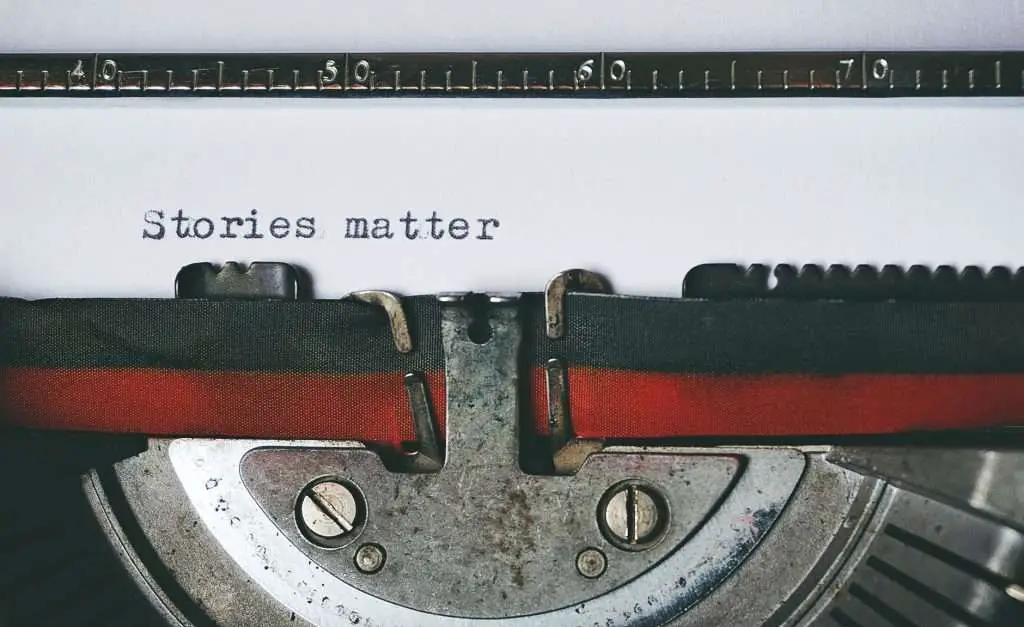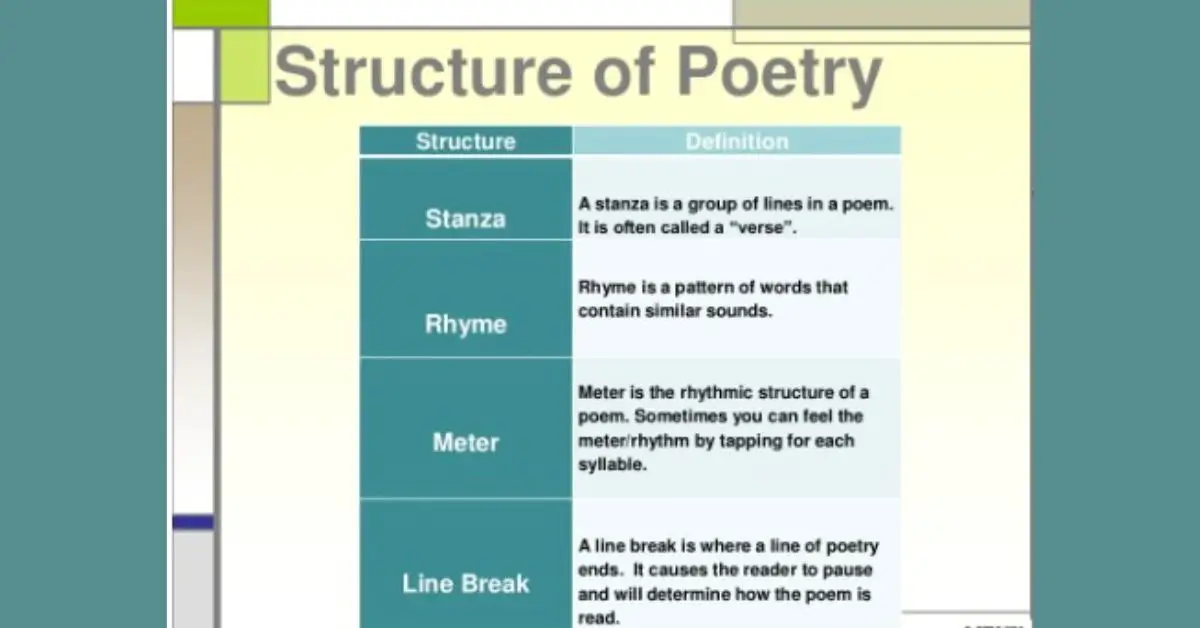What is Poetry

Poetry is a type of literature that has been used throughout the world for centuries and in many languages. Poems tell a story and use techniques like rhyme and repetition to make them more accessible and enjoyable. There are many styles of poems, but most poems have three major elements: stanzas, lines, and poetic devices.
Poetry is a way to express feelings, emotions, and thoughts in a more concentrated way than regular writing. It allows for people to be able to use more figurative language and play with words more freely. They are organized in lines of verse, called stanzas or couplets.
Affiliate Disclaimer: This post may contain affiliate links, which means I will receive a commission if you make a purchase using these links.
Know the Rules
The rules of poetry are set in place for a few reasons. They help poets create form and determine the structure of line length, the stress of words, and rhythm. They also encourage originality by making it difficult to plagiarize. The rules provide guidance to the poet about what they’re trying to accomplish with their poem.
When you first start learning how to read poetry, you should know the basic rules of the language. Poets who write in English don’t usually use complex syntax, so you should learn the rules of grammar, punctuation, and rhyme. By understanding these rules, you will be able to understand and appreciate the work of other writers. After you have mastered the basics, you should move on to more advanced techniques. You can read poetry on your own, but it is best to get help from a teacher or tutor.
Some high school student dreads the mundane task of writing poetry. That is, until now. Believe it or not, poets are not just strange people who like to rhyme words together all day. They feel that they have an obligation to convey their messages through poetry because it is a form of art that is appealing and enjoyable to read.
Poetry experts often agree that poetry is one of the most difficult subjects to understand. Students are frequently asked to study poets like Shakespeare, Chaucer, and Byron. Students are also commonly asked to memorize poems like “The Raven” by Edgar Allan Poe, “The Highwayman” by Alfred Noyes, and “Narcissus” by Petrarch.
As you continue reading you will see that there are ways to learn how to read poetry easily for a better understanding of this literary art form.

Analysing a Poem
Poetry is a very integral part of human culture. It can be found in all major societies and periods, from the verse epics of Homer to the lyrics of contemporary rap music. One form that has always been popular is poetry. In a modern time, poets use words and imagery to create a personal reflection on life’s meaning and society’s values that may otherwise be inaccessible.
Analyzing a poem is no easy task. It takes time and patience to peel back the layers and reveal its true meaning. This process may take days or weeks, and in most cases, it is necessary to revisit the poem more than once to see all of its nuances. It is, however, worth the effort because every word of the poem has been carefully chosen and places a significant value on the importance of words in general.
A Poems Meaning
A poem’s meaning is more than just words arranged in a certain order. The meaning of a poem comes from how it speaks to the reader. Some poems are meant to be read aloud, while others are meant for quiet reflection. Others are open to interpretation- one person’s reading might not be the same as another’s, but they will still both have an individual understanding of the words.
A close analysis of the poem “The Second Coming” by William Butler Yeats can be found in the following introduction. The first sentence should give a general overview of the poem and offer context, including the use of apocalyptic imagery and the political and social environment during Yeats’ time. The second sentence should present a detailed summary of the argument for this interpretation and include references to other sources that agree with this interpretation. This would then be followed by an elaboration on his perspective. Read the full poem below:
The Second Coming
Turning and turning in the widening gyre
The falcon cannot hear the falconer;
Things fall apart; the centre cannot hold;
Mere anarchy is loosed upon the world,
The blood-dimmed tide is loosed, and everywhere
The ceremony of innocence is drowned;
The best lack all conviction, while the worst
Are full of passionate intensity.
Surely some revelation is at hand;
Surely the Second Coming is at hand.
The Second Coming! Hardly are those words out
When a vast image out of Spiritus Mundi
Troubles my sight: somewhere in sands of the desert
A shape with lion body and the head of a man,
A gaze blank and pitiless as the sun,
Is moving its slow thighs, while all about it
Reel shadows of the indignant desert birds.
The darkness drops again; but now I know
That twenty centuries of stony sleep
Were vexed to nightmare by a rocking cradle,
And what rough beast, its hour come round at last,
Slouches towards Bethlehem to be born?
Analyse the use of imagery
When you are analyzing a poem, focus on visual aspects, such as pictures and unusual word arrangements. When comparing a poem with a different one, focus on rhyming lines and repetition. Pay attention to sounds, rhythms, and punctuation as well. These factors will help you get a preliminary understanding of the structure of the poem. By the time you have mastered this skill, you can move on to exploring different poems.
Discuss the Poem with Others
Another helpful method is to talk to someone who knows how to read poetry. While this may seem daunting, it’s an effective way to better understand the work. There are many people on the Internet who can help you with your poetry questions. However, it’s important to remember that this is a process. Even professors continue to learn and master the craft well into their careers. If you want to understand poetry better, start by reading a variety of poems.
Understand the Speaker and Setting
When you’re learning how to read poetry, try to think about the setting and the speaker. By imagining these things, you’ll be able to better understand the work. In this way, you’ll be able to analyze the poem and appreciate it on a deeper level. When you understand the theme, you’ll be able to interpret the work in a more profound way.
The speaker in a poem is the author of the poem and is often communicating their thoughts or feelings. The language of poetry can be used to reveal the speaker’s perspectives on different ideas or what they are feeling, although it can also be used to obscure who they are so their true identities are hidden. Poetry is often set in a specific place and time, but this isn’t always the case.
Understanding what is being described in a poem depends on the speaker and the setting. Poems written by someone who is describing their personal experience are coming from their point of view, which often doesn’t allow for much outside interpretation. Poems that take place in a fictional world are told from an outsider’s perspective. Some poems take place in both settings, especially allegorical poetry, where the speaker uses one setting to talk about another topic.
The speaker and setting in poetry inform one another. It is important to keep both in mind when reading so you can fully understand what the poet is trying to convey.
Pay Attention to Grammar and Punctuation
Grammar and punctuation in poetry have been a controversial topic of debate since their earliest days. There are some poems where there is no punctuation used, and this is deliberately done by the poet to emphasize certain meanings. This poetic technique is called enjambment.
What is Enjambment?
Enjambment is a grammatical term for the continuation of one sentence into the next and can be used in many forms of literature, such as poetry and prose. There are three types of enjambment: syntactic, semantic, and pragmatic.
- Syntactic enjambment is when a syntactic unit is followed by another syntactic unit containing a different subject or predicate.
- Semantic enjambment occurs when the same subject is continued but with a different predicate.
- Pragmatic enjambment is a syntactic construction where a sentence or clause is left unfinished with the intention of continuing later.
If you’re confused about the grammar in a poem, try reading it again slowly or asking an English teacher for help. You may also want to take a look at the poem’s title to find out who wrote it, because some poets have specific rules they follow, while others do not.
It is important to have a good understanding of the use of grammar and punctuation when reading or writing any type of text, including poetry. In order to understand how this applies to poetry, it’s important to know the basics of how poets work with language. What distinguishes poetic language from prose is that poets usually restrict themselves to using certain sounds, rhythms, and literal meanings.
Some poets, such as A.E. Houseman, aim to produce a poem that is both lyrical and easy to understand. Others, such as Ezra Pound, see the use of grammar and punctuation as unnecessary restrictions from the reader’s understanding of the poem.
Grammar and punctuation in poetry are important because it dictates the meaning of the poem to the reader. It can be used to demonstrate formal poetry, as well as certain levels of diction. Punctuation is used to convey different types of emotions in poems. Some punctuation can also be used to differentiate between formal and informal language.
Read the Poem Aloud
There is nothing more enjoyable than reading a poem aloud to an audience. Poetry is meant to be spoken, not read on the page. It uses wordplay, rhythm, and rhyme for its power, not merely to convey information or emotion. When you read poetry aloud, it becomes dynamic. The words are alive with sound and insight. It’s like experiencing a concert in your own home without ever leaving your chair.
Poetry is usually meant to be read silently, but there are many poems that are more enjoyable when they are read aloud. The Love Song of J. Alfred Prufrock by T.S. Eliot is one such poem. It is great for reading out loud because it has some rhyming lines, which make it easier to remember the poem’s words and get through them smoothly.
Reading poems aloud can help us break out of the monotony of our day-to-day routines, and give us a space to reconnect with ourselves and others. When we read these words aloud, they become more than mere words on a page; they become something that has the power to heal.
A Simple Technique to Read and Understand Unfamiliar Poems
When reading a poem written by an unfamiliar poet, you might feel intimidated at first (see video below for more details). It’s perfectly fine to read a poem, but you should practice reading it several times. This will help you catch all the details of the poem and enjoy it more. Moreover, it’s good practice for you to have a few friends over to discuss the poem with. That way, you can be sure that they understand what you’ve read.
Know the Meaning of Words
The best way to understand a poem is to know its meaning. Knowing the meaning of words in poetry will help readers better understand what the poet is trying to say. When reading poetry, it’s important for a reader to take care not only to read the words on the page but also to consider what they mean.
It can be difficult to understand the meaning of words in poetry. The language is often very descriptive and has deep roots in symbolism, which can make it hard to distinguish the literal meaning of the words. Most words in poems have a special meaning for the poet and the reader of the poem. Poets use these words to help paint a picture or create a mood for the reader. To understand what is going on in a poem, readers need to study not only the poem’s subject but also what each word means.
The definitions of the words in poetry are not always what they seem to be. You need to take a closer look at the context of the poem to find out what the true meaning may be. In his poem Prelude, T.S. Eliot uses many synonyms for “death” as he talks about this inevitable reality of life and how it has a different meaning for each person. Poetry is greatly misunderstood because it’s hard for someone who doesn’t have an understanding of its meanings to know when they’re being misled.
Conclusion: How to Read Poetry
In conclusion, reading poetry can be a great way to enjoy literature and educate yourself. To get the most out of your reading experience, it’s important to read with a purpose. There are many different aspects of poetry that can be read and analyzed. In order to get the most out of your reading, you have to have an understanding of these different aspects so you can fully enjoy the poem.
Poetry is not just for English class, it can be enjoyed as a form of literature or as an inspiring way to relax. If you are looking for inspiration, poetry is the place to turn, and if you are looking for something fun to do on a rainy day, there is nothing better than reading some poetry. Reading poetry can be a rewarding experience. It could change your mood, inspire your creativity, or just make you feel more aware of the world around you. The best way to enjoy poetry is to get out there and start reading!
Thanks for taking the time to read. Feel free to share your thoughts in the comments section.


